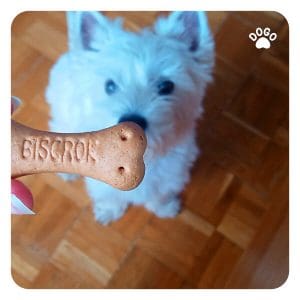
What Is Important in Training a Blind Dog?
1. Understanding
Before you ask your dog anything, try to put yourself in their shoes. If your pup has been healthy so far and has recently lost their eyesight, give them time to find their way in the new circumstance. Starting training at such a time can overwhelm your dog. Their world has changed 180 degrees – this is enormous stress!
Before you decide to start training a blind dog, ensure that your pet is familiar with their new living conditions. Be supportive. Arrange the home space so that it is safe for them. Walk them around the house again to create a new map in their mind. Praise and reward them when they start to move around independently. Don’t shout or punish them when they knock over a vase or a chair. Allow them to make mistakes; they are just discovering their new life.
If a pup has been blind since birth, it means that they have already learned to live without seeing images. They have already built up functioning patterns. Try to observe your pet for a while. Notice whether they pay more attention to sounds or smells – which of these are most interesting to them? Observe what your dog finds most challenging and what is trivial for them. It is an important step towards adjusting the difficulty of the tasks to your dog’s abilities.
One way to support a blind dog during training is to introduce them to audio cues. Audio cues can be used to get your dog’s attention, as well as to guide them. For example, you can use a clicker to signal to your dog that they have performed a correct behavior. You can also use different tones of voice to indicate different commands. Suppose you want your dog to stop or slow down. In that case, you can use a lower tone of voice, while a higher tone of voice can signal them to continue. In this way, your dog can learn to rely on their hearing and develop a strong sense of trust with you.
2. Improving Your Dog’s Self-Esteem

Try to lower your dog’s emotional level daily and reduce their stress. To get a calm and balanced pet, take care of all their basic needs.
-
Appropriate quantity and quality of walks
A daily dose of exercise is extra endorphins and a great way to tire your pet out. Make sure your walks are diverse and exciting. Allow your dog to pick up scents freely.
-
Proper quantity and quality of sleep
Good, deep sleep allows the body to regenerate and reduce cortisol levels in your pet’s body. Your dog should have their bed/kennel in a quiet part of the house. Remember never to disturb their rest.
-
Opportunity to have fun together
Nothing lifts the mood like a good time. Give your dog a little joy, and it will take away all the tension. You can, for example, organize a game of tug-of-war together. Check the DOGO app to see how to do it.
-
Satisfying the daily need for sniffing and chewing

-
Mental work
Learning is very pleasant and rewarding for dogs. However, it is essential to remember to make it an enjoyable and positive process. So how do you make this process enjoyable for a blind dog? Read on!
-
Calm atmosphere while leaving alone
Blind dogs can feel anxious when left alone, which can lead to destructive behaviors such as chewing furniture, digging holes, or barking excessively. To prevent this, you can try using calming aids such as pheromone diffusers or music therapy. Pheromone diffusers mimic the natural calming scent produced by a mother dog to soothe puppies. They can help to reduce anxiety levels in your pet and make them feel more secure. Music therapy has also been shown to have a calming effect on dogs. You can play classical music or nature sounds to create a relaxing environment for your pet.
3. Building the right relationship based on trust
An essential first step to training a blind dog is to build the right relationship with them. You need to earn their trust! Make them feel safe, comfortable, and at ease in your company. Try to show them support in difficult, stressful situations. Don’t yell at them when they are struggling with something. Be patient! Spend time with them in creative and exciting ways. Introduce a lot of joy and fun into your relationship. It will make your dog want to interact with you.
To build a strong bond with your blind dog, you can try introducing them to new smells and textures. Blind dogs rely heavily on their sense of smell to navigate the world. Therefore, you can use scents to create positive associations and stimulate their senses. You can introduce new smells by using essential oils, spices, or herbs. You can also let your dog explore different textures such as different types of fabrics, toys, and surfaces. This can help to keep them mentally stimulated and engaged.
4. Turn your dog’s dysfunction into their strengths
Blind dogs can excel in many activities, such as scent work, tracking, and obedience training. You can enroll them in classes specifically designed for blind and visually impaired dogs to learn new skills. These classes can help to build your dog’s confidence and provide them with socialization opportunities. You can also introduce your dog to new environments to challenge their skills. For example, you can take them on a hike or to a new park to expose them to new sights, smells, and sounds. This will help to keep them mentally stimulated and engaged. Remember, a blind dog can achieve anything that a sighted dog can with the right training and support.
Don’t focus on the fact that your dog has lost their sight. Remember that they still have two valuable senses – hearing and smell. Usually, when a dog loses their sight, their other senses sharpen. Take advantage of it! In the DOGO app, you can introduce all commands by guiding your dog to the correct position with a treat. Your dog doesn’t need to see the treat to follow it – they need to smell it. Make sure the treat’s smell is intense. If you have observed your dog before, you know which scents are most attractive to them. According to our instruction, you can add verbal commands to the exercises, to which the dog should react in the final result of the training. If you additionally use a clicker for training, you will make the dog’s task easier!
What is a clicker, and how does it work?

Final Tips
Ultimately, a blind dog should respond to your verbal commands. For obvious reasons, gesturing will not be necessary. Therefore, make sure that the commands you say are intoned in various and interesting ways. Dogs pay much more attention to high-pitched tones. Do not forget to give enthusiastic praise to your pet.
While training a blind dog, Remember to adjust the expectations of your dog according to their abilities. If you expect the impossible from them, you will create demotivating pressure. Such training is not enjoyable or effective. Instead, enjoy the process of learning together. Support your dog and appreciate any progress you manage to make. Good luck!






